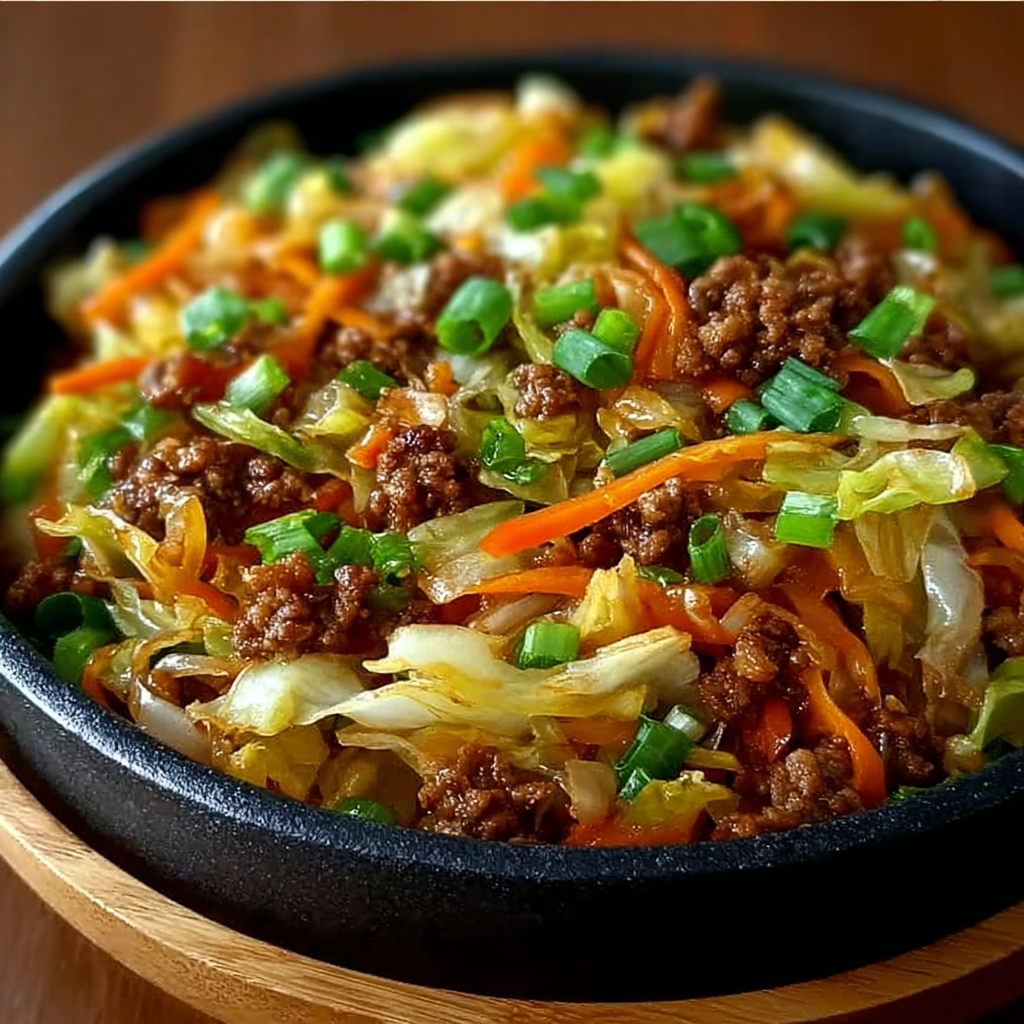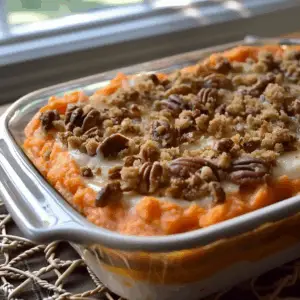Enjoy a flavorful, healthy twist on a classic cabbage stir fry that aligns with low-carb living and packs a punch of savory satisfaction. Whether you follow Keto, Paleo, or Whole30, this recipe delivers bold taste without grains.
Beyond indulgence, understanding how low-carb meals support balanced metabolism is essential. Explore more about the fundamentals of a low-carb diet and the nutritional power of cabbage to appreciate why this dish excels in both health and flavor. For a deeper dive, see the Health & Dietary Benefits section.
In this article, you’ll discover:
- Ingredient selection tips for lean ground beef and crisp cabbage
- Aromatic sauce components and cooking techniques
- Variations to customize heat and umami
- Meal prep strategies and storage hacks
- Tips for garnishing with sesame seeds and scallion greens
Refer to Ingredient Deep Dive and Step-By-Step Cooking Instructions for full details. Enjoy a balanced meal that delights.
Health & Dietary Benefits
Low-carb meals can transform metabolic health, supporting stable blood sugar and sustained energy throughout the day. By focusing on net carbs and nutrient density, this stir-fry aligns with popular diet-friendly plans and provides balanced macros without sacrificing flavor.
Following a low-carb diet reduces glycemic spikes and promotes weight management by lowering the glycemic load of each meal. Explore foundational low-carbohydrate diets and our own low-carb diet principles to understand how cutting net carbs optimizes insulin response. Incorporating leafy vegetables like cabbage enhances satiety and nutrient density in a single skillet dish.
Lean ground beef provides high-quality protein and micronutrients such as iron and zinc, supporting muscle maintenance and immune function. Cabbage contributes fiber, vitamin C, and vitamin K for digestive health and strong bones. For more on the nutritional profiles, see Ground beef nutrition and Cabbage health benefits. The combination of protein and fiber lowers the meal’s glycemic index, making it suitable for sustained energy release and appetite control. Learn how to prepare these ingredients step by step in our Step-by-Step Cooking Instructions, ensuring optimal texture and flavor.
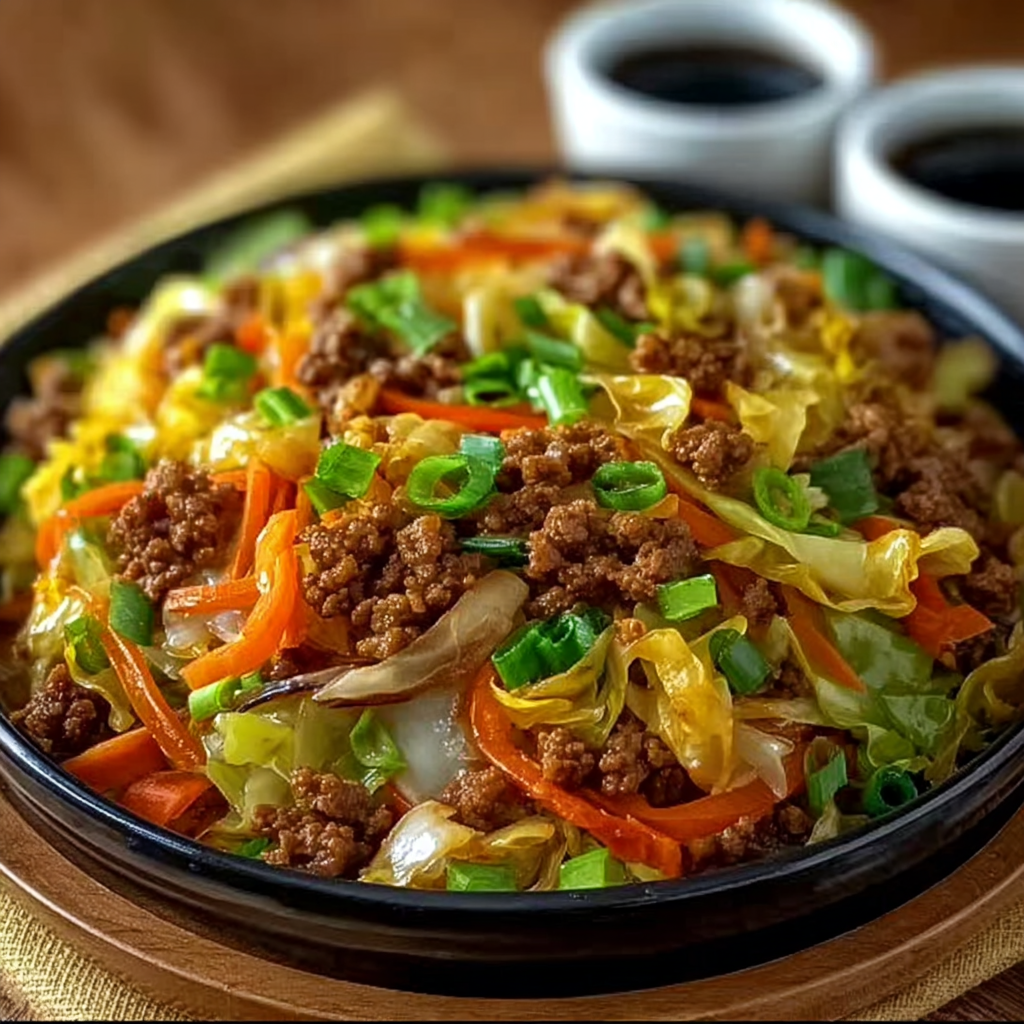
Ingredient Deep Dive
Delving into each component ensures your stir fry achieves optimal taste and texture. Understanding the role of fat content, slicing techniques, and flavor enhancers will elevate this nutritious, time-efficient, satisfying, delightful dish.
- Lean ground beef: Opt for 90/10 or 93/7 to balance juiciness and protein. Grass-fed varieties offer richer micronutrients.
- Green cabbage: Choose crisp, firm heads; slice thinly against the grain to ensure tender, evenly cooked strands that retain a slight crunch.
- Aromatics: Fresh garlic, grated ginger, and the white parts of green onions build a fragrant base foundational in Stir-frying techniques and Chinese cuisine overview.
- Sauce components: Low-sodium soy sauce, oyster sauce, hoisin sauce, and rice vinegar form a balanced umami blend. Substitute coconut aminos for a Paleo swap.
- Thickener: A cornstarch slurry ensures sauce adhesion; arrowroot powder works for Whole30 adaptations.
- Finishing touches: Drizzle toasted sesame oil, garnish with sesame seeds and green scallion tops for visual appeal and flavor contrast.
Refer back to our Health & Dietary Benefits section and explore inspiring variations on our Paleo Chinese recipe collection or Keto stir-fry recipe board for extra creativity.
Equipment & Prep
Setting up proper tools streamlines your stir fry journey, ensuring swift transitions between steps. A well-prepped station minimizes stress and maximizes flavor retention.
For guidance on choosing cookware, explore our wok vs. skillet comparison and learn when to use a nonstick skillet for optimal results.
See our cookware essentials guide today.
- Wok vs. nonstick skillet for even heat distribution
- Sharp chef’s knife and sturdy cutting board for precise slicing
- Spatula or wooden spoon to toss ingredients easily
- Mixing bowls for sauces and cornstarch slurry
- Measuring spoons for accurate seasoning
- Oven mitts or heat-resistant gloves for safe handling
Step-by-Step Cooking Instructions
Mastering the technique ensures tender meat, crisp cabbage, and a glossy, flavorful sauce that clings perfectly to each ingredient. Follow these steps carefully to achieve restaurant-quality results every time.
Begin by heating sesame oil in a hot wok or skillet until fully shimmering, about one minute. Add lean ground beef and season lightly with salt and pepper. For detailed comparisons between cooking vessels, refer to our wok vs. skillet comparison and explore creative twists on the Stir-fry inspiration board.
Next, stir in garlic, ginger, and white scallion segments for thirty seconds to unlock aromatic depth. Toss in the sliced cabbage until it wilts slightly. Meanwhile, whisk together low-sodium soy sauce, oyster sauce, hoisin sauce, chili-garlic sauce, and rice vinegar in a bowl. Check cabbage health benefits on Wikipedia and compare ground beef nutrition at Wikipedia for detailed micronutrient info.
- Heat 1 tablespoon of sesame oil in a large wok or nonstick skillet over medium-high heat until fully shimmering, about one minute only.
- Add 1 pound of lean ground beef and break it apart with a spatula. Season lightly with salt and pepper. Cook five minutes.
- Push beef to one side of the pan. Add minced garlic, grated ginger, and white scallion parts; stir-fry briefly thirty seconds until fragrant.
- Combine beef with aromatics and stir briefly. Add sliced cabbage and toss evenly continuously for four minutes until it softens but remains crisp.
- In a small bowl, whisk two tablespoons low-sodium soy sauce, tablespoon oyster sauce, tablespoon hoisin sauce, teaspoon chili-garlic sauce, and tablespoon rice vinegar.
- Pour the sauce into the pan, tossing ingredients to coat. Stir in the cornstarch slurry, cooking one to two minutes until sauce thickens.
- Remove the pan from heat, transfer the stir fry to a serving platter, and garnish with toasted sesame seeds and green scallion tops.
Sauce Variations & Flavor Twists
Experimenting with sauce variations elevates your stir fry with customized heat, tang, and umami. Whether craving fiery spice or complex flavor, these twists add depth without extra carbs.
For a spicy kick, stir in more chili-garlic sauce or sriracha, and top with fresh chilis—ideal for fans of bold heat (Keto stir-fry recipe board), Low-carb meal ideas, or explore our internal low-carb diet principles guide. Try swapping oyster sauce with fish sauce for umami richness, referencing Stir-frying techniques or sampling classic recipes on the Stir-fry inspiration board. Dive into traditional methods via the Chinese cuisine overview.
Explore tangy profiles by increasing rice vinegar or adding lime juice. Use coconut aminos in place of soy sauce for a Paleo swap—see our Paleo Chinese recipe collection, consult the Whole30 diet guide, check ground beef nutrition on Wikipedia, or learn about cabbage health benefits via Wikipedia. Rotate flavors seasonally for continued excitement and versatility.
Nutritional Breakdown
Understanding the macronutrient and micronutrient profile helps you see how this dish supports balanced eating. Below is a breakdown per serving of calories, protein, fat, and net carbs, as well as key vitamins and minerals.
- Calories (320 kcal): Delivers steady energy without excess, fitting clean-eating goals.
- Protein (28 g): Builds and repairs muscle, keeping you full longer.
- Fat (20 g): From sesame oil and beef, enhances flavor and nutrient absorption.
- Net Carbs (6 g): Low impact on blood sugar, perfect for Keto and low-carb approaches.
- Vitamins C & K: Boosts immunity, collagen formation, bone strength, and healthy clotting.
- Iron & Zinc: Supports oxygen transport, metabolic health, and immune function.
Fitting this meal into daily macros is effortless for those following a Paleo or Whole30 approach. For guidance on managing net carbs, refer to our internal low-carb diet principles and the official Whole30 diet guide. Discover creative serving ideas on the low-carb meal ideas board or browse the Keto stir-fry recipe board for extra inspiration.
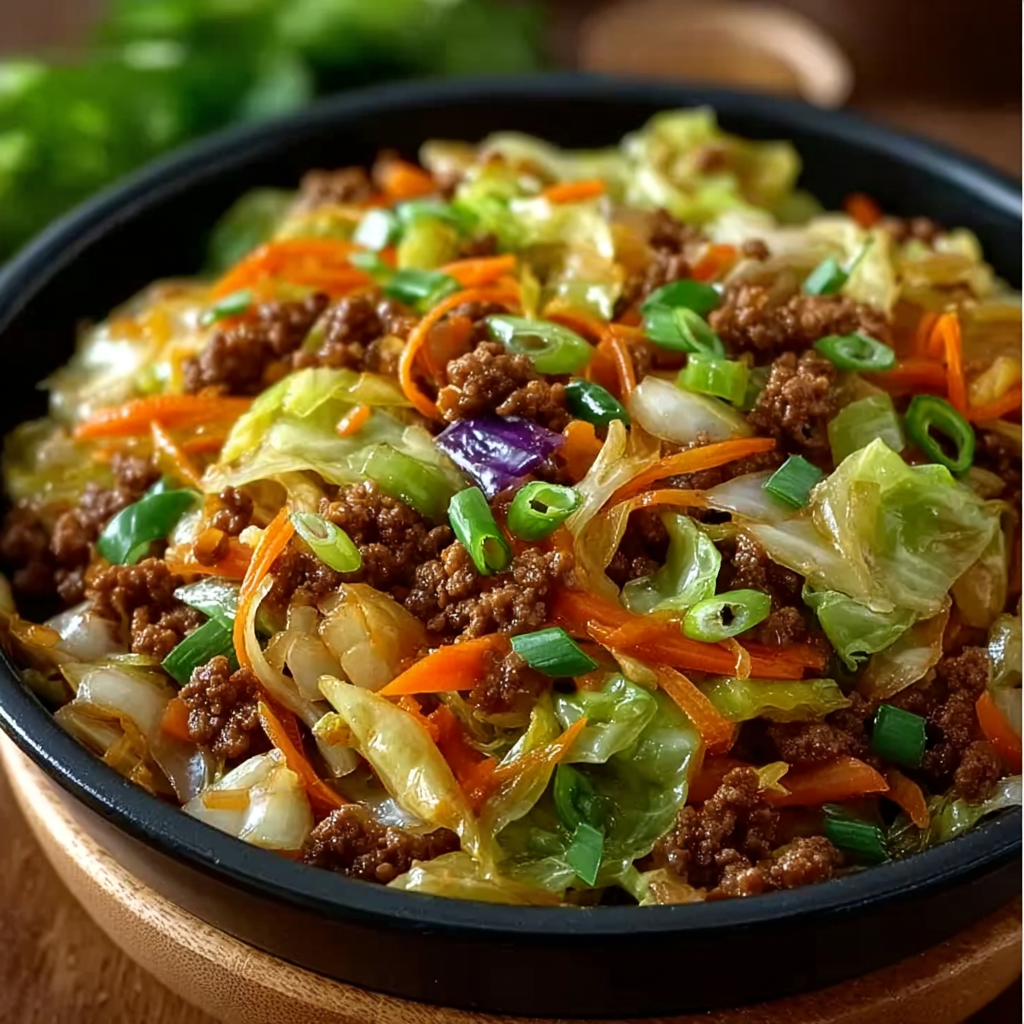
Serving Suggestions
Elevate your beef & cabbage stir fry with complementary sides and garnishes that enhance both texture and flavor:
- Garnishes
- Toasted sesame seeds for crunch
- Extra scallion greens for color and freshness
- Fresh cilantro leaves or lime wedges for bright contrast
- Low-Carb Sides
- Cauliflower rice tossed with garlic and herbs—perfect for soaking up sauce
- Shirataki noodles lightly sautéed in garlic oil
- Steamed broccoli or bok choy drizzled with sesame oil
- Meal-Prep Bowls
- Layer cauliflower rice, stir fry, and avocado slices in airtight containers
- Top with a drizzle of chili-garlic sauce for an on-the-go spicy kick
For seasonal twists, explore our Paleo Chinese recipe collection or find new plating ideas on the Stir-fry inspiration board. If you prefer extra veggies, see our guide to low-carb meal ideas and add colorful peppers or snow peas.
Meal Prep & Storage
Streamline your week by cooking once and enjoying multiple meals:
- Portioning
- Divide stir fry into individual containers; aim for 1½ cups per serving
- Store with silicone sauce cups to keep garnishes fresh
- Refrigeration
- Keeps well for 3–4 days when sealed tightly
- Refresh flavor by adding a splash of soy sauce or rice vinegar before reheating
- Freezing
- Freeze in meal-prep trays for up to one month
- Thaw overnight in the fridge, then reheat on the stovetop over medium heat
- Reheating Tips
- Stovetop: Add a teaspoon of water or broth to revive sauce
- Microwave: Cover loosely to trap steam and prevent drying
Refer to our kitchen tools guide for container recommendations and explore best practices in our food storage tips.
Dietary Adaptations & Substitutions
Customize to fit allergies, preferences, or ingredient availability without losing depth or authenticity:
- Protein Swaps
- Ground turkey, chicken, pork, or lamb—adjust cooking time as needed
- Vegetable Variations
- Napa cabbage, bok choy, or halved Brussels sprouts for different textures
- Sauce Alternatives
- Coconut aminos instead of soy sauce for gluten-free and Paleo
- Arrowroot powder in place of cornstarch for strict Whole30
- Heat Level
- Omit chili-garlic sauce for mild flavor or double it for extra spice
- Allergen-Friendly
- Use tamari in place of soy sauce to avoid wheat
- Swap oyster sauce for mushroom sauce to keep it vegetarian
For a full list of substitutions, see our ingredient swaps guide and review Whole30 diet guide on Wikipedia.
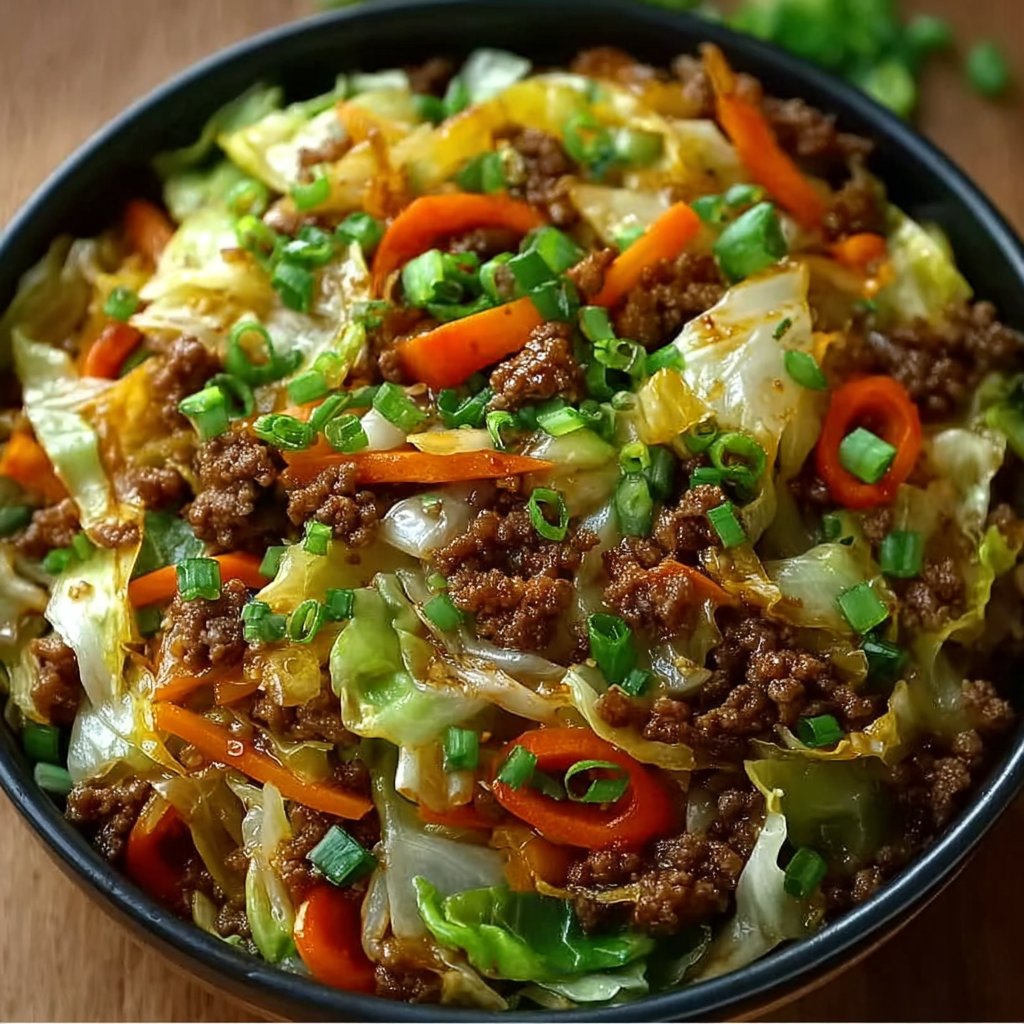
Frequently Asked Questions
1. Is ground beef good for low-carb diets?
Yes—lean ground beef is high in protein and healthy fats with minimal net carbs, making it ideal for Keto, Paleo, and Whole30. See detailed macros in our Low-carb diet principles.
2. Can I substitute arrowroot for cornstarch?
Absolutely. Arrowroot creates a clear, glossy sauce suitable for Paleo and Whole30, with a 1:1 substitution ratio.
3. How spicy does this get with chili-garlic sauce?
One teaspoon adds mild heat. Increase to two or more teaspoons—or top with sliced fresh chilies—for a fiery kick. Find more spicy options on the Keto stir-fry recipe board.
4. What’s the best way to reheat without drying out?
Use the stovetop over medium heat with a splash of water or broth. Cover and stir occasionally to redistribute moisture.
5. Can I prep this entirely ahead of time?
Yes—cook and cool fully, then store in airtight containers. Add garnishes and fresh scallions just before serving to preserve crunch.
6. Is hoisin sauce compatible with Whole30?
Most hoisin sauces contain sugar and non-compliant additives. Substitute with a compliant mushroom sauce or omit entirely.
The Ultimate Healthy Chinese Ground Beef and Cabbage Stir Fry Recipe
A low-carb Chinese cabbage stir fry featuring lean ground beef, tender green cabbage, and a savory, umami-rich sauce. This grain-free skillet dish comes together in under 20 minutes, making it perfect for weeknight dinners, meal prep, or special diets like Keto, Paleo, and Whole30. Each bite bursts with aromatic garlic, ginger, and scallions, finished with a silky sauce that clings to every strand of cabbage.
Ingredients
- 1 lb (450 g) lean ground beef
- 4 cups (about 1 small head) green cabbage, thinly sliced
- 1 Tbsp sesame oil
- 2 cloves garlic, minced
- 1 Tbsp fresh ginger, grated
- 3 green onions, thinly sliced (separate whites and greens)
- 2 Tbsp low-sodium soy sauce
- 1 Tbsp oyster sauce
- 1 Tbsp hoisin sauce
- 1 tsp chili-garlic sauce (optional, for heat)
- 1 Tbsp rice vinegar
- 1 tsp cornstarch mixed with 2 Tbsp cold water (slurry)
- Salt and pepper, to taste
- Sesame seeds, for garnish
- Extra green-onion greens, for garnish
Instructions
- Heat the sesame oil in a large skillet or wok over medium-high heat. Add the ground beef and cook, breaking it up with a spatula, until no longer pink and lightly browned. Season lightly with salt and pepper.
- Push the beef to one side of the pan. Add the garlic, ginger and the white parts of the green onions. Stir-fry for about 30 seconds, until fragrant.
- Stir the aromatics into the beef, then add the sliced cabbage. Cook, stirring frequently, until the cabbage begins to wilt, about 3–4 minutes.
- In a small bowl, whisk together the soy sauce, oyster sauce, hoisin sauce, chili-garlic sauce (if using) and rice vinegar. Pour over the beef and cabbage, tossing to coat everything evenly.
- Give the cornstarch slurry a quick stir and pour it into the pan. Continue cooking for another 1–2 minutes, until the sauce has thickened slightly and clings to the beef and cabbage.
- Taste and adjust seasoning with extra soy sauce or a pinch of salt and pepper, if needed. Remove from heat.
- Transfer to a serving platter and sprinkle with sesame seeds and the reserved green-onion tops. Serve immediately.
Notes
-
Meat Choice: Opt for 90/10 or 93/7 ground beef for ideal juiciness and macro balance; grass-fed adds extra nutrients.
-
Cabbage Prep: Thin, uniform slices ensure even cooking—slice against the grain for tender-crisp texture.
-
Sauce Slurry: Stir the cornstarch slurry just before adding to prevent separation.
-
Make-Ahead Tips: Store sauce separately if freezing to maintain consistency.
-
Flavor Boosts: Add a dash of fish sauce for deeper umami or a squeeze of lime for brightness.
-
Garnish Timing: Sprinkle sesame seeds and scallion greens right before serving to keep them crisp.
